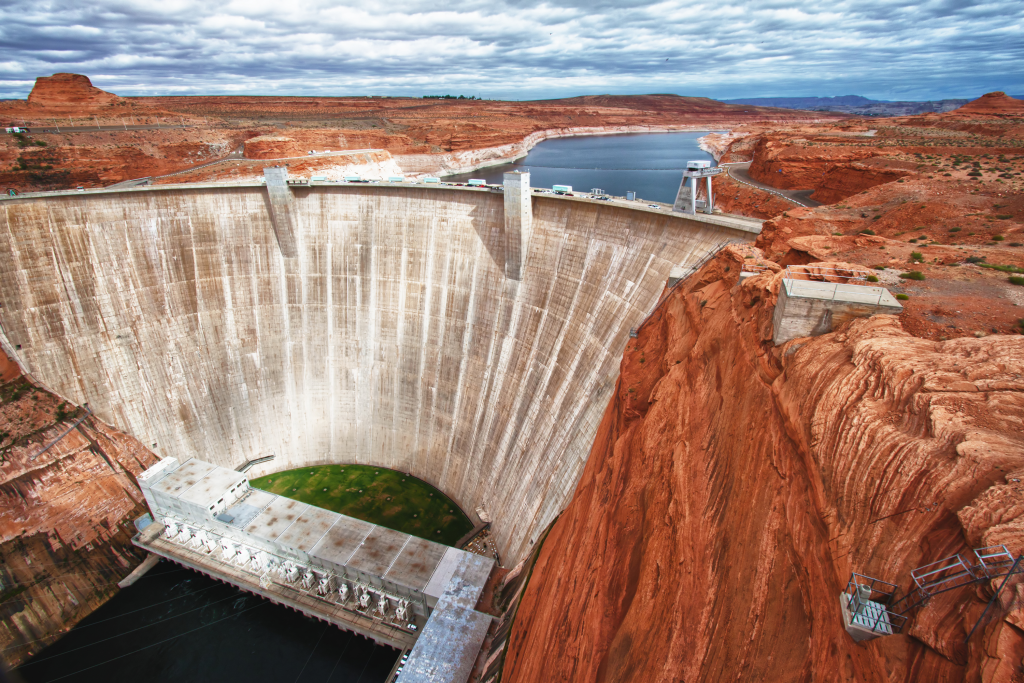Glen Canyon Dam Might Collapse
Glen Canyon Dam drowned a canyon and changed the river’s ecology. Climate change increases the cycles of extreme droughts and extreme floods, making the dam system vulnerable. Glen Canyon Dam has long been known to be a risk. The most recent flood approaching the observed 100-year average on the Colorado occurred 130 years ago. In 1884, twice the average annual flow of the river passed through Grand Canyon from April to July. The current system has yet to face half of this water volume. When it did in 1983, the spillways at Glen Canyon Dam above Grand Canyon National Park nearly collapsed.
The hydraulic pressure tore through the spillways’ concrete tunnels, eroding the dam from the inside out. Outside, plywood was erected atop the spillway gates to help hold back advancing waters. Nature relented just in time to head off the dam’s failure, and the contents of one of the nation’s largest reservoirs racing unchecked to an equally full Lake Mead and Hoover Dam.
Bureau of Reclamation Warning
The Bureau of Reclamation warns that such a release would result in a surge of water through the Grand Canyon of heights ranging from 310 to 570 feet. The torrent would eventually over-top Hoover Dam destroying its hydro electric plant. The plume of water cresting the dam would reach nearly 70-feet and last about 11 days. Hoover Dam itself would be expected to survive, but how and if it along with Nevada’s water intake infrastructure could continue to operate is unknown.
Moreover, below Hoover Dam lies much of the water delivery infrastructure for Southern California, Arizona and Mexico, along with one of the most productive agricultural regions in the world. Critical infrastructure including highways, bridges, pipelines, transmission lines serving Los Angeles, San Diego, Phoenix, Tucson and Tijuana would be damaged. The 8,000 square-miles of below sea level farmland cultivated in what’s known as the Salton Sink would likely fill with water that would be trapped for years.
Keep in mind, that when Glen Canyon’s spillways failed, they were operating at only 20 percent of their designed capacity. And the combined discharge through the dam’s entire system was but one-third of the estimated 1884 peak rates. While repairs and design modifications have since been made, they have never been tested for these types of flows, nor has its flood-management guidelines been modified to mitigate the likelihood Glen Canyon Dam would be forced to operate under such stress.
Lake Powell Wastes Water
Billions of gallons of water stored in its reservoir are lost annually to evaporation and seepage into the soft sandstone that surround it. Numerous locations exist to more efficiently store Lake Powell’s water in off-stream, underground aquifers similar to what Las Vegas has been doing for years with surplus water from Lake Mead.
Glen Canyon Dam Harms The River’s Ecosystem
During its lifetime, Glen Canyon Dam has wreaked havoc on the ecosystem of Grand Canyon National Park. In blocking the Colorado’s natural flows, the dam has transformed the aquatic habitat that helped support one of the most unique assemblages of native fish in the world, to one where some of these species have gone extinct and others are just holding on awaiting a return of those natural process that may allow recovery to occur.

